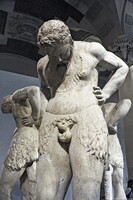| dc.coverage.spatial | Site: Musée du Louvre (Paris, Île-de-France, France) MR 183-MR 186 | en_US |
| dc.coverage.temporal | altered ca. 1750 (alteration); ca. 100-200 (creation) | en_US |
| dc.creator | unknown (Ancient Roman) | en_US |
| dc.date | 100-199 | en_US |
| dc.date.accessioned | 2013-08-30T18:49:30Z | |
| dc.date.available | 2013-08-30T18:49:30Z | |
| dc.date.issued | 100-199 | en_US |
| dc.identifier | 231947 | en_US |
| dc.identifier.other | archrefid: 2393 | en_US |
| dc.identifier.uri | http://hdl.handle.net/1721.3/140196 | |
| dc.description | Detail of head and torso of a satyr; Three Roman atlantes that formerly supported a fountain at the Villa Albani, Rome. They belong to a group of four characters similar in those found in the theatre of Dionysos in Athens. Abundantly restored, they were transformed into the support of a fountain basin by Cardinal Albani (1692-1779): as such they are seen in the works of several contemporary painters, including Hubert Robert. Source: Louvre Museum [website]; http://www.louvre.fr/ (accessed 4/18/2011) | en_US |
| dc.format.medium | marble | en_US |
| dc.rights | © Scott Gilchrist, Archivision, Inc. | en_US |
| dc.subject | literary or legendary | en_US |
| dc.subject | mythology (Classical) | en_US |
| dc.subject | Imperial (Roman) | en_US |
| dc.title | Atlantes in the form of Satyrs | en_US |
| dc.title.alternative | Satyres en Atlante | en_US |
| dc.type | image | en_US |
| dc.rights.access | Licensed for educational and research use by the MIT community only | en_US |
| dc.identifier.vendorcode | 7A3-CA-SA-A3 | en_US |
| vra.culturalContext | Ancient Roman | en_US |
| vra.technique | carving (processes) | en_US |
| vra.worktype | sculpture (visual work) | en_US |
| vra.worktype | atlas (supporting element) | en_US |
| dc.contributor.display | unknown (Ancient Roman) | en_US |


